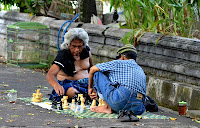The bride had warned us - and anticipating our helplessness in the face of daunting tasks such as sari fittings and communicating with Tamil-speaking drivers, the bride enlisted an army of friends and relatives to escort (er . . . babysit) us about Chennai. (If not for their help and guidance I'd probably still be trying to figure out how to tie a sari.)
Things kicked off the night we arrived with a 'small get-together for close friends and family' (probably around 100 people) at the home of the parents of the bride. There was a huge marquee bedecked with jasmine flowers, a well stocked open bar and buffet and a local DJ was on hand to play some Tamil classics. It was easily the equivalent of your average Western wedding reception - and this was just the pre-warm-up, warm-up.
This was followed by a hungover shopping frenzy - all the girls getting fitted for saris, salwar kameez and stocking up on matching bangles whilst the boys fussed over kurtas and sandals.
Our next event was Sangeet. Sangeet has northern Indian origins (from the Punjab) but is widely practised throughout the country (and certainly within the Indian diaspora).
Loosely defined Sangeet is a grand affair during which the friends and family of the bride and groom perform a range of traditional (and not-so-traditional) songs and dances - rehearsed for weeks - even months in advance.
 Sangeet was like a night at the Oscars (or perhaps the Bollywood equivalent) - the bride and groom literally looked like movie stars. It was almost inconceivable to me that this was the same girl with whom I had shared a dank, crappy dorm with as a graduate student.
Sangeet was like a night at the Oscars (or perhaps the Bollywood equivalent) - the bride and groom literally looked like movie stars. It was almost inconceivable to me that this was the same girl with whom I had shared a dank, crappy dorm with as a graduate student. Next up was Mehndi - another open bar affair at another posh hotel. The bride spent the majority of the day perched on a throne whilst four women attended to her covering her hands and feet in henna. Female guests also queued up to have a mini-version done on their own hands.
After Mehndi came the engagement and finally the wedding itself. The engagement and wedding take place at a marriage hall. The engagement began with a procession of singers and dancers followed by the bride and groom in a horse drawn carriage. (This is followed by a lot of stuff, which quite frankly I didn't understand!) The following day at the appropriate auspicious time as determined by the Tamil calendar the wedding ceremony begins. In this case a very early 5:00am.
There were priests chanting in Sanskrit (I think) whilst the groom was primed for the ceremony. Following this was a fantastic display of the groom 'running away' as the bride 'chased' after him. Persuaded to return, the bride and groom are hoisted on the shoulders of friends while the bride attempts to çapture' her husband by throwing a wreath of jasmine around his neck. (This was again followed by several costume changes and lots of things I didn't understand).
There were well over 1000 people in attendance. About a week after the wedding I was chatting to the mother of the bride and she said, 'oh I keep bumping into people we forgot to invite, I'm so embarassed!'
It was a truly unforgettable experience and I really (still) can't thank Lavanya and Ayyappan enough for their attention and hospitality. (You can have no idea how glad I am that they came to our wedding first - theirs would have been an impossible act to follow.)
I would of course also like to add a great big happy first wedding anniversary to Ayyappan Hariharan and Lavanya Iyer. Their first baby is also due today (but is so far showing no signs of making an appearance!)
PS Indian weddings are not for the faint of heart. Pack plenty of asprin.
-----------------------------------------------------------------------------------------
You can also view my photos of Sangeet, Mehndi and the wedding.











